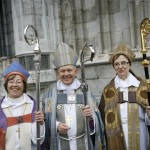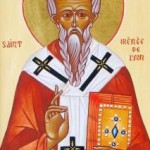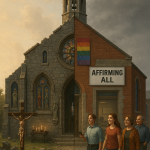On Monday the Church of England did not simply vote to ordain women as bishops. The members of the General Synod made an even more historic decision.
They decided once and for all the true nature of the Church of England.
After the Protestant Revolution of the sixteenth century it was very clear for three hundred years that the Church of England was a Protestant Church. Anti-Catholic sentiment ran high in the established church, and for three hundred years Catholics were a persecuted minority. Only in 1829 with the passage of the Catholic Relief Act did Catholics in England begin to reclaim their freedoms.
On July 14 1833 John Keble preached his famous sermon on National Apostacy–which is regarded by historians as the beginning of the Oxford Movement. (You can read the sermon here) In one of those nice historical co-indidences (if you believe in such things) the Church of England General Synod’s vote in favor of women bishops took place on the 181st anniversary of Keble’s sermon.
The essential point of the Oxford Movement–coming just a decade or so after Catholic Emancipation–was that the Church of England was not, at it’s core, a Protestant Church, but the ancient Catholic Church reformed. The men of the Oxford Movement were called “tractarians” after the series of leaflets or tracts written and published by John Henry Newman and his friends. In tracts and sermons the Tractarians tried to re-weave into the three hundred year old Protestant Church of England a new Catholic strand. (Read more about Newman here) The success of the Anglo-Catholic movement was a witness to their work. Not only in theology, but in literature and liturgy, in art and architecture, in music and academic studies there was a flourishing revival of a Catholic sentiment and spirituality.
It was, however, simply an additional Anglican costume. Already within the Church of England there were two strands: the old Protestant liberal strand of religion which was firmly attached to the principles of the Enlightenment, bonded with the political establishment and which was upper class, educated and elitist. The Methodist movement of the eighteenth century grafted onto the historic Protestant, rationalist liberalism a new kind of Evangelical, Calvinist fervor. Now, a century after the Wesleys (and also springing from Oxford) the Tractarians added a Catholic strand which came to be called Anglo-Catholicism.
For the next 180 years (1833 – 2014) members of the Church of England were able to perpetuate the Tractarian myth–the nineteenth century invention that the Church of England was, in fact, the ancient Catholic Church in England–but properly reformed. This idea of the Anglican Church as the Reformed Catholic Church in England seemed credible enough. After all, the Church of England occupied all the ancient Catholic parish churches, cathedrals and colleges in the land. At the back of the village church where I was a vicar one could see the sign of all the incumbents down through the ages from the first record keeping in the eleventh century to the present day. Not only did the Church of England occupy the ancient buildings, but with the Anglo Catholic movement the clergy looked Catholic. After the triumphs of the Tractarians an increasing number wore Catholic vestments, lit candles, used incense, studied the church fathers, installed images into their churches and made room for the Virgin Mary. After the second world war the Anglo Catholics, with their dedication to the urban poor enjoyed a surge of popularity. With the liturgical changes of the 1960s and thereafter the Eucharist–which had in many places been celebrated only monthly–became the main weekly form of worship. The new Anglican liturgy resembled the new Catholic version. Archbishops Fisher and Ramsey met with the pope and ecumenical discussion were started. It even seemed that the Ancient but Reformed Catholic Church in England would be re-united with her mother church.
So it might have been, had the Church of England continued on that trajectory.Continue reading.











